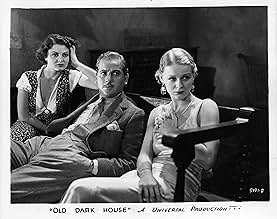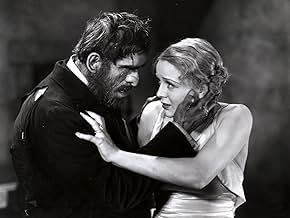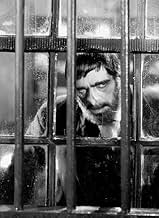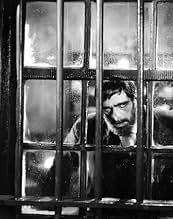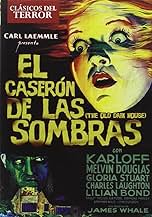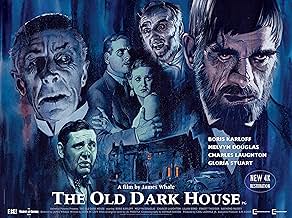NOTE IMDb
7,0/10
14 k
MA NOTE
Cherchant refuge pendant un orage, cinq voyageurs sont bons pour une nuit bizarre et terrifiante lorsqu'ils tombent sur le domaine familial des Femm.Cherchant refuge pendant un orage, cinq voyageurs sont bons pour une nuit bizarre et terrifiante lorsqu'ils tombent sur le domaine familial des Femm.Cherchant refuge pendant un orage, cinq voyageurs sont bons pour une nuit bizarre et terrifiante lorsqu'ils tombent sur le domaine familial des Femm.
- Réalisation
- Scénario
- Casting principal
- Récompenses
- 1 nomination au total
Avis à la une
Tod Browning (Freaks, Dracula), Karl Freund (The Mummy, Mad Love), Fritz Lang (Metropolis, M) and James Whale
. these are the guys that created the fabulous horror genre as we know it. And try to pick the most essential movie from Whale's repertoire! Alongside 'Bride of Frankenstein', this has got to be his finest creation and easily one of the most influential films ever made. The Old Dark House is a gripping mix of suspense and macabre black humor. The story is ridiculously simple and shows 5 people stranded near a remote, sinister house during a storm. There, they encounter the vicious and eccentric Femm family. The butler (played by the legendary Boris Karloff) is a dumb, scar-faced drunk; the lady of the house is deaf and aggressive and her brother speaks with an incomprehensible accent. On top of this, there's a bearded lady in the attic (supposed to be a 102-year-old guy) and a deranged pyromaniac brother locked up in yet another room! It sounds a little like the TCM Sawyer family forty years ahead of time. Whale constantly inserts subtle humor into his film, without actually losing a bit of the sublime Gothic atmosphere. This may well be the very FIRST haunted-house movie and he already makes it some sort of parody.
The Old Dark House is one of the lesser-known classic Universal horror movies, which is quite a shame. It's excellent every way you look at it. At first, it might seem a little slow (especially compared to Whale's equally brilliant 'Frankenstein' and 'The Invisible Man') but that's quickly made up by the utterly unique characters this film features. Classic, efficient horror like they'll never make it anymore.
The Old Dark House is one of the lesser-known classic Universal horror movies, which is quite a shame. It's excellent every way you look at it. At first, it might seem a little slow (especially compared to Whale's equally brilliant 'Frankenstein' and 'The Invisible Man') but that's quickly made up by the utterly unique characters this film features. Classic, efficient horror like they'll never make it anymore.
Seeking shelter from a storm, five travelers are in for a bizarre and terrifying night when they stumble upon the Femm family estate.
The film is based on the novel "Benighted" (1927) by J. B. Priestley, who saw the "queer inmates" of the house as symbols of post-war pessimism. He was quite reluctant to sell the rights, thinking his characters would not adapt well to the screen. However, in January 1932, he changed his mind when Universal offered him $12,500 (roughly $215,000 in 2017 money).
The novel was adapted for the screen by R. C. Sheriff ("The Invisible Man") and Benn Levy (Hitchcock's "Blackmail"). Universal Studios producer Carl Laemmle invited Levy from England to Universal City after being impressed with Levy's screenplay for "Waterloo Bridge" (1931), which was also directed by James Whale. Sheriff and Levy were able to have a script fleshed out by March 1932, a mere two months.
James Whale worked with many collaborators from his previous films including Arthur Edeson, who was the cinematographer for "Frankenstein" (1931) and "Waterloo Bridge" (1931) and set designer Charles D. Hall, who also worked on "Frankenstein". Edeson went on to help create the American Society of Cinematographers (ASC) and become its president. Hall kept "Old Dark House" very scaled back; a viewer could easily mistake the film for a stage production. Ultimately, Hall would work on 11 of Whale's 20 films.
For genre fans, the most obvious repeat collaborator is Boris Karloff, who plays the supporting role of a mute butler. Interestingly, though Karloff's best-known role is Frankenstein's Monster (under Whale's direction), and Whale's best-known film (also "Frankenstein") starred Karloff, the two were not necessarily friends. Cordial, yes, but never close, and yet their names are linked for all eternity.
The cast is all-star by anyone's standards. Whale chose newcomer Gloria Stuart for the glamour role, and this lead to her wider success and her helping found the Screen Actors Guild (SAG). She would soon work with Whale again on both "The Kiss Before the Mirror" and "The Invisible Man", both released in 1933. This was Charles Laughton's first Hollywood film, which came shortly after Laughton had worked with Whale on the English stage.
Laughton was married to Elsa Lanchester, who played the title role in Whale's "Bride of Frankenstein" (1935). "Old Dark House" also started Ernest Thesiger's Hollywood career, and he would go on to work on Whale's "Bride" as Dr. Septimus Pretorius, a role that the studio wanted Claude Rains to have. Of course, Thesiger embodies that role and is as memorable as the bride herself. At the time of casting "Old Dark House", Thesiger had already known Whale and was appearing in one of Benn Levy's plays.
According to Stuart, Whale was a very hands-on director, deciding line delivery, walking, costumes and more. She saw him as an "artist" with his background in both acting and set design, and was "fussy" about makeup, jewelry and props. Because of his rapport with Thesiger, Whale allowed for the most deviations from the script (and book) for his old friend.
"The Old Dark House" was largely ignored at the American box office, although it was a huge hit in Whale's native England. Variety and the Hollywood Filmograph gave the film negative reviews, with Variety calling it a "somewhat inane picture". Other reviews were more positive, but on the whole it was not seen as an instant classic, much to the astonishment of modern audiences.
For many years, the original version was considered a lost film and gained a tremendous reputation as one of the pre-eminent Gothic horror films. Whale's fellow director and friend Curtis Harrington ("Night Tide") helped to prevent "The Old Dark House" from becoming a lost film. Harrington met Whale and Whale's partner David Lewis in 1948, at a time when (according to Harrington) "Whale had no critical reputation at all", unlike how film historians view him today.
When Harrington was signed to Universal in 1967 to direct "Games" with James Caan, he repeatedly asked Universal to locate the film negative of "Old Dark House", although it was Harrington himself who discovered a print of the film in the vaults of Universal Studios in 1968. He persuaded James Card the George Eastman House film archive to finance a new duplicate negative of the poorly-kept first reel, and restore the rest of the film. The original nitrate negative had survived, though the first reel only existed as a lavender protection print.
Harrington further was the one responsible for getting the film legally released. Because Universal had not pursued the copyright, the rights to the story reverted to the Priestley estate and were bought up by Columbia, who released an inferior remake by acclaimed director William Castle in 1963. Harrington was able to convince Columbia to allow copies of the Universal film to be made, though it would be years before distribution and re-screenings were legally cleared.
In 2017, the Cohen Film Collection released a brand new Blu-ray featuring a 4K restoration that brings this classic back to life. They also packed the disc with two different commentaries (one with actress Gloria Stuart, the other with James Whale biographer James Curtis). There is a featurette on how Curtis Harrington saved the film from obscurity, and a completely new 15-minute interview with Sara Karloff.
The film is based on the novel "Benighted" (1927) by J. B. Priestley, who saw the "queer inmates" of the house as symbols of post-war pessimism. He was quite reluctant to sell the rights, thinking his characters would not adapt well to the screen. However, in January 1932, he changed his mind when Universal offered him $12,500 (roughly $215,000 in 2017 money).
The novel was adapted for the screen by R. C. Sheriff ("The Invisible Man") and Benn Levy (Hitchcock's "Blackmail"). Universal Studios producer Carl Laemmle invited Levy from England to Universal City after being impressed with Levy's screenplay for "Waterloo Bridge" (1931), which was also directed by James Whale. Sheriff and Levy were able to have a script fleshed out by March 1932, a mere two months.
James Whale worked with many collaborators from his previous films including Arthur Edeson, who was the cinematographer for "Frankenstein" (1931) and "Waterloo Bridge" (1931) and set designer Charles D. Hall, who also worked on "Frankenstein". Edeson went on to help create the American Society of Cinematographers (ASC) and become its president. Hall kept "Old Dark House" very scaled back; a viewer could easily mistake the film for a stage production. Ultimately, Hall would work on 11 of Whale's 20 films.
For genre fans, the most obvious repeat collaborator is Boris Karloff, who plays the supporting role of a mute butler. Interestingly, though Karloff's best-known role is Frankenstein's Monster (under Whale's direction), and Whale's best-known film (also "Frankenstein") starred Karloff, the two were not necessarily friends. Cordial, yes, but never close, and yet their names are linked for all eternity.
The cast is all-star by anyone's standards. Whale chose newcomer Gloria Stuart for the glamour role, and this lead to her wider success and her helping found the Screen Actors Guild (SAG). She would soon work with Whale again on both "The Kiss Before the Mirror" and "The Invisible Man", both released in 1933. This was Charles Laughton's first Hollywood film, which came shortly after Laughton had worked with Whale on the English stage.
Laughton was married to Elsa Lanchester, who played the title role in Whale's "Bride of Frankenstein" (1935). "Old Dark House" also started Ernest Thesiger's Hollywood career, and he would go on to work on Whale's "Bride" as Dr. Septimus Pretorius, a role that the studio wanted Claude Rains to have. Of course, Thesiger embodies that role and is as memorable as the bride herself. At the time of casting "Old Dark House", Thesiger had already known Whale and was appearing in one of Benn Levy's plays.
According to Stuart, Whale was a very hands-on director, deciding line delivery, walking, costumes and more. She saw him as an "artist" with his background in both acting and set design, and was "fussy" about makeup, jewelry and props. Because of his rapport with Thesiger, Whale allowed for the most deviations from the script (and book) for his old friend.
"The Old Dark House" was largely ignored at the American box office, although it was a huge hit in Whale's native England. Variety and the Hollywood Filmograph gave the film negative reviews, with Variety calling it a "somewhat inane picture". Other reviews were more positive, but on the whole it was not seen as an instant classic, much to the astonishment of modern audiences.
For many years, the original version was considered a lost film and gained a tremendous reputation as one of the pre-eminent Gothic horror films. Whale's fellow director and friend Curtis Harrington ("Night Tide") helped to prevent "The Old Dark House" from becoming a lost film. Harrington met Whale and Whale's partner David Lewis in 1948, at a time when (according to Harrington) "Whale had no critical reputation at all", unlike how film historians view him today.
When Harrington was signed to Universal in 1967 to direct "Games" with James Caan, he repeatedly asked Universal to locate the film negative of "Old Dark House", although it was Harrington himself who discovered a print of the film in the vaults of Universal Studios in 1968. He persuaded James Card the George Eastman House film archive to finance a new duplicate negative of the poorly-kept first reel, and restore the rest of the film. The original nitrate negative had survived, though the first reel only existed as a lavender protection print.
Harrington further was the one responsible for getting the film legally released. Because Universal had not pursued the copyright, the rights to the story reverted to the Priestley estate and were bought up by Columbia, who released an inferior remake by acclaimed director William Castle in 1963. Harrington was able to convince Columbia to allow copies of the Universal film to be made, though it would be years before distribution and re-screenings were legally cleared.
In 2017, the Cohen Film Collection released a brand new Blu-ray featuring a 4K restoration that brings this classic back to life. They also packed the disc with two different commentaries (one with actress Gloria Stuart, the other with James Whale biographer James Curtis). There is a featurette on how Curtis Harrington saved the film from obscurity, and a completely new 15-minute interview with Sara Karloff.
The Old Dark House is the least well known of James Whale's four horror pictures, but don't let that fool you, as this one is just as good as anything else Whale ever made. Despite being over seventy years old, The Old Dark House still holds the power to feel like it could have been released yesterday; much like the rest of Whale's horror movies, which are as fresh today as they were the day they were made. The plot follows three people that get caught in a storm and are forced to take refuge in the only place nearby - an old dark house. There, they encounter the house's strange inhabitants - a nearly deaf woman and a cowardly old man, along with their creepy butler (played by Boris Karloff), a scar faced drunk. More travellers turn up, and the film only gets more fun; introducing us to more strange characters, including a very weird old lady...with a beard, and something else, which is so horrible that the inhabitants are forced to keep it under lock and key
The Old Dark House is one of the first haunted house films ever made, and it works, primarily, for two reasons; the house itself and the cast of characters. Both of these entities are intriguing elements in their own right, and they combine to great effect. The house is, as you might expect, old and dark; and it's a sublime horror setting because of that. It creates a constant sense of malice and through it's dark corridors and many rooms, Whale is able to make the house into a labyrinth where we can believe that anything can happen. This coupled with the fact that the 'normal' people in the house are stranded there, thus creating claustrophobia along with the raging storm outside makes for an atmosphere that is as dark and morbid as anything that cinema has ever given us. The characters inside the house are enigma's themselves; each one is as frightening and inventive as the other, and they have all been imitated several times by later horror films. Even the travellers that are stranded in the house are given unique to each other. Whale also uses a few of these characters to implement his own brand of black humour (which can be felt strongly in his other three films as well). Many horror films don't work character-wise because they're all so similar to each other; but this film certainly doesn't suffer from that.
Overall, The Old Dark House is another feather in Whale's already feather filled cap. It's as genius as any of his other horror films and overall it's a crying shame that Whale didn't do more work in that genre, as that is the genre that is so rightfully his. If I haven't made it clear enough already: this film comes with the highest recommendation from me.
The Old Dark House is one of the first haunted house films ever made, and it works, primarily, for two reasons; the house itself and the cast of characters. Both of these entities are intriguing elements in their own right, and they combine to great effect. The house is, as you might expect, old and dark; and it's a sublime horror setting because of that. It creates a constant sense of malice and through it's dark corridors and many rooms, Whale is able to make the house into a labyrinth where we can believe that anything can happen. This coupled with the fact that the 'normal' people in the house are stranded there, thus creating claustrophobia along with the raging storm outside makes for an atmosphere that is as dark and morbid as anything that cinema has ever given us. The characters inside the house are enigma's themselves; each one is as frightening and inventive as the other, and they have all been imitated several times by later horror films. Even the travellers that are stranded in the house are given unique to each other. Whale also uses a few of these characters to implement his own brand of black humour (which can be felt strongly in his other three films as well). Many horror films don't work character-wise because they're all so similar to each other; but this film certainly doesn't suffer from that.
Overall, The Old Dark House is another feather in Whale's already feather filled cap. It's as genius as any of his other horror films and overall it's a crying shame that Whale didn't do more work in that genre, as that is the genre that is so rightfully his. If I haven't made it clear enough already: this film comes with the highest recommendation from me.
It's a funny experience when a film evokes déjà vu, only to realize the source of the déjà vu is, itself, intended to itself incite déjà vu. Picture this: a miserable storm sweeps a carload of normal people, as earnest as they are bedraggled, into taking refuge at a spooky old manor, only to be besieged and coveted by the prurient, camp Gothic inmates. But don't do the Time Warp again just yet: at the core of this Russian Doll of horror, pastiche, and dark humour lurks James Whale's oft-overlooked but seldom forgotten mini- masterpiece – The Old Dark House. As Poe-faced as if the script had been quoth by the Raven itself, Whale's film is, if not the granddaddy of most horror clichés, then at least the wry, drunken great-uncle. And, weathered as it is, time has been kind to this one, making The Old Dark House a creepy, clever, and sordidly amusing addition to the pantheon of horror classics. Singing not included; pelvic thrusting barely omitted.
If nothing else, The Old Dark House makes for a fascinating transitional tonal touch-point for Whale, one of the defining masters of classical horror. The film isn't as overtly satirical and camp as Whale's later monster mash-terpieces, The Invisible Man and, especially, Bride of Frankenstein, but it certainly shows him creeping in that direction, with a persistent snicker of irreverent naughtiness under its raspy breath. This isn't to say the film is an outright farce - indeed, Whale runs the gamut of thematic leitmotifs that would proceed to become preoccupations for decades of horror to follow: dogmatic religion, lurid sexuality, class discrepancies, and shunned, disabled family members. Yet, his film crackles with an invigorating, nervy energy, and his characters banter with zingy, pre-screwball fury, with several double-entendres pushing the boundaries of Hays Code knuckle-rapping with cheeky aplomb (maybe Whale assumed American censors wouldn't understand them through the Welsh accents?).
His setup is certainly foreboding enough, with the harried car ride prelude across flooding, lightning-scarred Welsh countryside a perfectly ominous amuse-bouche for the sinister, Gothic castle theatrics to come. Whale's flair for atmospheric mise-en-scène is superb, peppering the film with marvelously spooky flourishes and Expressionist lighting keeping the audience biting their nails throughout (one bit, where a woman makes shadow puppets on the wall with her hands, only to have a dark figure emerge from the shadow, is a jump scare for the ages). But Whale bides his time, keeping his pacing cunningly slow and allowing his film to froth at the mouth with looming tension.
Whale's film is also remarkable for the unprecedented access the audience is given to his cabal of characters. Too many horror films introduce characters as disposable (and disposed of) props, but Whale treats the first half of his potboiler like a theatre piece, as the growing crowd of storm refugees and reluctant hosts meet, and poke hopes, dreams, prejudices, and – mostly – fears out of each other. Whale's ensemble rises to the challenge, delivering genuinely well-crafted and compelling characters, particularly the suave, sharp-tongued Melvyn Douglas, the tough but chipper Lilian Bond, and, especially, Charles Laughton, who gives a remarkably heartfelt performance, his effete bluster whisking away to reveal a man plagued by terrible loneliness underneath. His monologue, revealing his bitter turn to capitalism as a means of finding purpose and escaping past tragedy, is strangely tragic and surprisingly moving amidst the film's tongue-in-cheek tone, and a curious counterpoint to Depression-era cinema's usual propensity for portraying the super-rich as vacuous twits. Ernest Thesiger and Eva Moore deliver masterclasses of brooding as the manor's sister tenants, while title star Boris Karloff is genuinely terrifying, his performance so much more affecting than the mere rage-ravaged riff on his Frankenstein lumbering and grunting you'd initially expect. Finally, Brember Wills gives a performance so deft and daringly over-the-top that he turns horror conventions on their head even while pushing new boundaries of skin-crawling, especially for the 1930s.
Whale's quieter companion piece to his more famous forays into the macabre may tip the cap more at Hitchcock than Mary Shelley, but ably continues his macro theme of humans being far more terrifying than any conventional 'monsters.' The Old Dark House may be humbler in scope, and somewhat more tonally imbalanced than some of its cohort of horror classics (including a swooning romantic subplot that's altogether too saccharine and sincere to play amidst its sardonic surroundings). Still, at a mere 72 minutes, the film is as concise and sardonically sinister as it is creepy, and still a slice of spine-tingling fun for an eerie, rainy night.
-8/10
If nothing else, The Old Dark House makes for a fascinating transitional tonal touch-point for Whale, one of the defining masters of classical horror. The film isn't as overtly satirical and camp as Whale's later monster mash-terpieces, The Invisible Man and, especially, Bride of Frankenstein, but it certainly shows him creeping in that direction, with a persistent snicker of irreverent naughtiness under its raspy breath. This isn't to say the film is an outright farce - indeed, Whale runs the gamut of thematic leitmotifs that would proceed to become preoccupations for decades of horror to follow: dogmatic religion, lurid sexuality, class discrepancies, and shunned, disabled family members. Yet, his film crackles with an invigorating, nervy energy, and his characters banter with zingy, pre-screwball fury, with several double-entendres pushing the boundaries of Hays Code knuckle-rapping with cheeky aplomb (maybe Whale assumed American censors wouldn't understand them through the Welsh accents?).
His setup is certainly foreboding enough, with the harried car ride prelude across flooding, lightning-scarred Welsh countryside a perfectly ominous amuse-bouche for the sinister, Gothic castle theatrics to come. Whale's flair for atmospheric mise-en-scène is superb, peppering the film with marvelously spooky flourishes and Expressionist lighting keeping the audience biting their nails throughout (one bit, where a woman makes shadow puppets on the wall with her hands, only to have a dark figure emerge from the shadow, is a jump scare for the ages). But Whale bides his time, keeping his pacing cunningly slow and allowing his film to froth at the mouth with looming tension.
Whale's film is also remarkable for the unprecedented access the audience is given to his cabal of characters. Too many horror films introduce characters as disposable (and disposed of) props, but Whale treats the first half of his potboiler like a theatre piece, as the growing crowd of storm refugees and reluctant hosts meet, and poke hopes, dreams, prejudices, and – mostly – fears out of each other. Whale's ensemble rises to the challenge, delivering genuinely well-crafted and compelling characters, particularly the suave, sharp-tongued Melvyn Douglas, the tough but chipper Lilian Bond, and, especially, Charles Laughton, who gives a remarkably heartfelt performance, his effete bluster whisking away to reveal a man plagued by terrible loneliness underneath. His monologue, revealing his bitter turn to capitalism as a means of finding purpose and escaping past tragedy, is strangely tragic and surprisingly moving amidst the film's tongue-in-cheek tone, and a curious counterpoint to Depression-era cinema's usual propensity for portraying the super-rich as vacuous twits. Ernest Thesiger and Eva Moore deliver masterclasses of brooding as the manor's sister tenants, while title star Boris Karloff is genuinely terrifying, his performance so much more affecting than the mere rage-ravaged riff on his Frankenstein lumbering and grunting you'd initially expect. Finally, Brember Wills gives a performance so deft and daringly over-the-top that he turns horror conventions on their head even while pushing new boundaries of skin-crawling, especially for the 1930s.
Whale's quieter companion piece to his more famous forays into the macabre may tip the cap more at Hitchcock than Mary Shelley, but ably continues his macro theme of humans being far more terrifying than any conventional 'monsters.' The Old Dark House may be humbler in scope, and somewhat more tonally imbalanced than some of its cohort of horror classics (including a swooning romantic subplot that's altogether too saccharine and sincere to play amidst its sardonic surroundings). Still, at a mere 72 minutes, the film is as concise and sardonically sinister as it is creepy, and still a slice of spine-tingling fun for an eerie, rainy night.
-8/10
Truly one of Universal greatest unsung horror films, The Old Dark House is a unique blend of gothic setting, quirky characterizations, wicked black and dry humour, a great ensemble cast, and the workings of the mind of James Whale. Whale made the film the year after Frankenstein. He was again paired with Karloff. But unlike their first association, Karloff's star is far less brighter in this film as his performance, although good and servicable, is over-shadowed by atmosphere, Whale's direction, witty dialogue, and a cast of scene stealers such as Melvyn Douglas, Charles Laughton, Eva Moore, and Ernest Thesiger. Others in the notable cast include lovely Gloria Stuart, Lillian Bond, and Raymond Massey. Thesiger and Moore, as the brother and sister imposed upon by travellers in the stormy night, are fantastic as they interact and play out their eccentricities to perfection. Thesiger has the choice lines in the film as the effeminate Horace Femm, a cowardly man that cowers to his deaf sister. He is a joy to watch and each of his lines oozes with oil. Moore is also very good as she bellows repeatedly, "N beds! No beds! They can have no beds!" The story is based on a novel by J. B. Priestly. The plot is somewhat antiquated now, but Whale's direction puts a lot of life into it. And let's not forget Karloff, however small his part, still turns in a great menacing performance as a lecherous, drunken servant named Morgan ogling Gloria Stuart from the moment he sees her. The Old Dark House is a great film, and it should be more highly touted by Universal!
Le saviez-vous
- AnecdotesThis was Boris Karloff's first credited starring role. His name had been left off the Frankenstein (1931) publicity packages and only credited in the end credits of that film.
- GaffesOne of Gloria Stuart's elaborate earrings is missing about mid-film, it reappears for 2 close up shots and disappears again in medium and long shots.
- Citations
Rebecca Femm: [feels the fabric of Margaret Waverton's low-cut gown] Fine stuff, but it'll rot.
Rebecca Femm: [touches Margaret's skin above the neckline] Finer stuff still, but it'll rot too!
- Crédits fousBefore the Universal Pictures logo: PRODUCER'S NOTE: - Karloff, the mad butler in this production, is the same Karloff who created the part of the mechanical monster in "Frankenstein". We explain this to settle all disputes in advance, even though such disputes are a tribute to his great versatility
- ConnexionsEdited into Pale Moonlight Theater: The Old Dark House (2015)
- Bandes originalesSingin' in the Rain
(uncredited)
Music by Nacio Herb Brown
Lyrics by Arthur Freed
Sung by Melvyn Douglas a cappella, with modified lyrics
[Penderel sings the song in the car as the he and the Wavertons make their way on the washed out road]
Meilleurs choix
Connectez-vous pour évaluer et suivre la liste de favoris afin de recevoir des recommandations personnalisées
Détails
- Date de sortie
- Pays d’origine
- Langue
- Aussi connu sous le nom de
- L'appel de la chair
- Lieux de tournage
- Société de production
- Voir plus de crédits d'entreprise sur IMDbPro
Box-office
- Montant brut aux États-Unis et au Canada
- 25 678 $US
- Montant brut mondial
- 34 649 $US
- Durée1 heure 12 minutes
- Couleur
- Rapport de forme
- 1.37 : 1
Contribuer à cette page
Suggérer une modification ou ajouter du contenu manquant

Lacune principale
By what name was Une soirée étrange (1932) officially released in India in English?
Répondre


